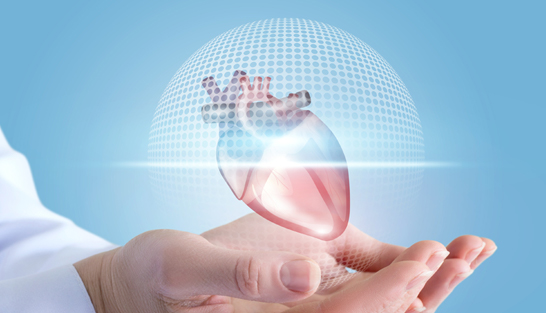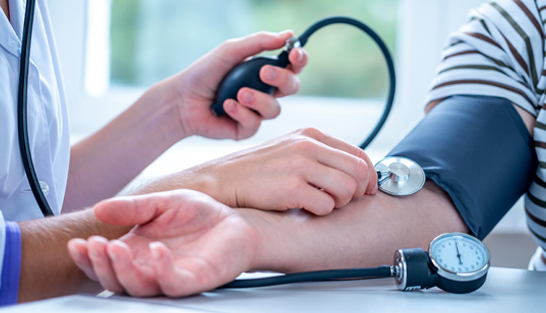



Hypertension is elevated blood pressure. When blood circulates in the body, a force pushes the blood. When this force/pressure is high, it is known as Blood Pressure or Hypertension.
Blood pressure is measured in two numbers known as the systolic and diastolic numbers.
The systolic pressure is the pressure when the heart beats and the diastolic pressure is the measurement of the pressure in the arteries between the heartbeats.
While the reading of both numbers is vital to diagnose the condition and treatment, it is the top number or systolic pressure that doctors take into consideration since it is the measurement of the force with which the heart pumps out blood to be carried out to the entire body.
Therefore, Blood pressure or Hypertension is a medical condition that is silent but serious in nature. Serious because it can significantly increase the risks of heart, brain, kidney and other diseases. It is also a significant cause of premature death in adults.
There are mainly two types of Hypertension:
Primary Hypertension is also known as essential Blood pressure and it is usually caused by an unhealthy/sedentary lifestyle. The other cause is natural ageing. This type of Hypertension builds up gradually over the years.
Secondary Hypertension is caused due to various underlying conditions. This kind of high Blood pressure can also be due to the medications taken for chronic diseases. The appearance of this can be sudden as opposed to primary Hypertension.


Some of the medical conditions that can contribute to secondary Hypertension are:
Sometimes just getting a health check-up causes anxiety and can shoot up blood pressure. This is called white-coat Hypertension.
Some other types of Hypertension are:
Isolated systolic Hypertension –
When the systolic Blood pressure is above 140 mmHg and diastolic Blood pressure is under 90 mmHg, it is known as isolated Hypertension. This is a common phenomenon in older adults.
Resistant Hypertension –
When the Blood pressure is constantly above the targeted levels of treatment and difficult to control, it is known as resistant Hypertension. Management of Resistant Hypertension includes maximisation of lifestyle interventions, use of additional anti-hypertensives, and, If Blood pressure remains uncontrolled, referral to a hypertension specialist is advised.
Malignant Hypertension –
Malignant Hypertension occurs when a sudden spike in blood pressure puts you at risk for organ damage. It often happens in people with a history of high blood pressure. But it can also occur in people with normal blood pressure. The condition is a medical emergency that requires immediate care. Usually an emergency situation, the readings are higher than 180/120 mmHg.

This disease is often referred to as the Silent killer, the symptoms of Hypertension are usually not very pronounced or significant. As a result, most people carry on with their lives without even realising that they could be suffering from High Blood Pressure or Hypertension.
Though some of the symptoms can be moderate to severe headaches, anxiety, shortness of breath, palpitations and, in some cases, bleeding of the nose, these signs could often come at a later stage and in cases where one has had High Blood pressure for some time.
The only way to keep oneself updated about this condition is to have regular health check-ups and have a medical professional measure their blood pressure.
This is a quick and painless process and now there are devices available that make it possible to check the pressure at home. But this should not replace medical evaluation and advice.
There are three stages of Hypertension which are:
Normal where the Blood pressure reading would be under 130/80 mmHg. This is normal and not a stage of Hypertension.
The next stage is mild Hypertension, where the Blood pressure reading would be 130-139/or diastolic between 80-89 mmHg.
In stage two, which is moderate Hypertension, the Blood pressure would read 140/90 mmHg or higher.
The last or critical stage of Hypertension that needs immediate medical attention is also known as Hypertensive Crisis. In this stage, the Blood pressure reading can be as high as 180/120 mmHg or higher.

There are some prerequisites, just like any other health conditions, that can put one on the high-risk criteria and the factors that contribute to this are:


One of the major organs that get affected by uncontrolled Hypertension is the heart. The Blood pressure, if it stays elevated at all times, can make the arteries hard, causing a decrease in blood flow and oxygen flow to the heart.
This reduction in blood flow can also cause other complications like:
Hypertension can also cause significant complications in pregnancy.
The various types of Hypertension during pregnancy are:
Chronic Hypertension this could be Hypertension pre-pregnancy.
Gestational Hypertension or Hypertension develops during pregnancy, especially around 20 weeks or later, more towards the delivery date. This could also lead to the development of full-fledged/chronic Hypertension later in the future.
Preeclampsia is a condition that appears during the later part of pregnancy and can be dangerous. In this case, there is an appearance of protein in the urine and the pregnant woman can experience swelling. Another effect of this is that the person may experience seizures due to the effect of Hypertension on other organs.
Symptoms of preeclampsia:
Chronic Hypertension with superimposed preeclampsia is a condition where pregnant women with chronic Hypertension are at higher risk for developing preeclampsia.
Regular Blood pressure checks during your appointments can highlight the condition in time for treatment.

Though one may have maintained their Blood pressure well, some triggers must be looked out for. These are a few things that may cause a spike in Blood pressure.

Blood pressure is checked using a cuff placed around the arm. The fitting of the cuff is vital as the readings can be wrong if the cuff does not fit well. The cuff is inflated with a hand pump or, in the case of modern instruments with automated machines.
It is vital to check Blood pressure in both arms when checked for the first time to look for any difference in the reading. Once this is done, the arm which shows higher reading should be used.
Blood pressure is usually measured in millimeters of mercury (mm Hg) and the reading has two numbers.
High blood pressure (Hypertension) is diagnosed if the blood pressure reading is equal to or greater than 130/80 mm Hg.
A diagnosis of high blood pressure is usually based on the average of two or more readings taken on separate occasions.
Blood pressure is grouped according to how high it is. This is called staging. Staging helps guide treatment.
Sometimes the bottom blood pressure reading is regular (it is lower than 80 mm Hg), but the top number is on the higher side.
This is known as isolated systolic Hypertension and is a common type of high blood pressure in people older than 65.

Blood Pressure Levels
| Normal | systolic: < 120 mm Hg |
| diastolic: < 80 mm Hg | |
| Elevated | systolic: 120–129 mm Hg |
| diastolic: < 80 mm Hg | |
| High blood pressure | systolic: 130 mm Hg or higher |
| diastolic: 80 mm Hg or higher |
From the onset of Hypertension, it takes years to cause severe damage unless the Blood pressure is highly elevated. However, if the symptoms are detected at an early stage, it can help in controlling damage.
If you visit your health care provider and these tests are done in time, it can help detect High Blood Pressure and the possible damage it can cause.
These tests can help us pinpoint the underlying causes of Hypertension.
Urine tests
to identify if any kidney diseases are present
Blood tests
to look for imbalances in the kidney function (blood urea and creatinine levels), electrolytes, thyroid function
Ultrasound
to check for any kidney disease
Some advanced tests may be required when it appears that Hypertension is due to some other medical condition, but that disease is not apparent on the above tests. These include:
Blood tests
to measure hormone levels
Urine tests
to measure hormone levels
Doppler test
to check the kidney’s arteries
CT scan
of the abdomen to check for abnormalities of the gland

Apart from the tests mentioned above, additional tests are done to check the risk for Heart Disease and comprehensive assessments can help identify damage to blood vessels.
Then some tests are carried out to check cardiac damage due to Hypertension. Damage caused to the blood vessels and other organs may not be symptomatic initially, but it is essential to be on the lookout and these tests might help detect the signs.
Ophthalmoscopic tests
in case of hypertensive damage to the eyes these test are helpful.
Urine examination,
checking of urine protein levels and urine protein-creatinine ratio help detect damage to the kidney.
X-Ray Imaging
will help identify any if there are any abnormalities in the size of your heart.
Electrocardiogram (ECG OR EKG)
to monitor the heart’s electrical activity. This will also help diagnose hypertension-related complications like ischemic, hypertrophy, and other cardiac diseases.
An echocardiogram or Cardiac Ultrasound
is used to capture actual images of the beating heart on a video screen, helping identify the damage caused by Hypertension to the heart due to muscular thickening, stiffness of heart muscle and weakening of the chambers of the heart.
Arterial Stiffness Assessment
is a test that is non-invasive in nature and helps monitor the blood vessel condition caused by Hypertension. Often High Blood pressure can stiffen the blood vessels and cause damage to organs. By doing this test, it is possible to diagnose it earlier on.
Like most conditions, Hypertension or High Blood pressure, if left untreated, can cause serious health problems. Here is a list of a few:
Heart attack
Thickened and hardened arteries are a complication of High blood pressure and can lead to heart attacks.
Aneurysm
Blood vessels can get bulged and weaken due to High blood pressure causing an aneurysm.

Heart failure
It becomes difficult for the heart to pump blood in the usual fashion as the heart’s pumping chamber walls thicken due to increased blood pressure.
Kidney disease or failure
Untreated and undiagnosed hypertension can lead to damage to the blood vessels of the kidneys. This can lead to kidney failure.
Vision loss A poor diet that keeps the Blood pressure constantly high and untreated Blood Pressure can lead to complications relating to the vision and there may subsequently be complete vision loss.
Sexual dysfunction One of the other lesser-known complications arising out of High Blood pressure, erectile dysfunction and low sex drive in males. In females, it can cause vaginal dryness and arousal issues.
Angina
Reduced blood flow can cause chest pain, also known as Angina which gives a feeling of tightness, pressure or heaviness in the chest.
Peripheral artery disease (PAD)
Reduced blood flow due to narrowed arteries causes a circulatory problem known as Peripheral artery disease (PAD).
Metabolic syndrome
A group of risk factors that can involve chances of developing heart disease, stroke and type 2 diabetes. High blood pressure, High blood sugar levels, low HDL or good cholesterol levels, high triglyceride levels and excess fat around the waist are some more risks in the group.
Memory loss or understanding troubles
High Blood pressure can also lead to memory loss or difficulty understanding basic concepts. It can cause impairment in thinking, learning and remembering.
Dementia
Narrowed or blocked arteries limit the flow of blood to the brain and can be a cause of dementia. This condition can cause memory loss, inability to perform tasks like problem-solving, lower attention span and affect thinking abilities affecting daily activities.
When one is diagnosed with a health condition, one must alter one’s lifestyle to keep the situation under control. The same applies in the case of Hypertension. While one must follow the prescribed medication, these lifestyle changes can significantly help.
Shrink that waistline: Increased weight can put you at a higher risk of High Blood pressure and if you are already diagnosed and are obese or overweight, losing weight can help reduce blood pressure. Also, having a wider waist can increase the risk of high blood pressure.

Exercise eagerly:
It has been observed that regular physical activity can lower high blood pressure. Therefore, 30 minutes of moderate physical aerobic exercise like walking, jogging, cycling, swimming or dancing every day is a must to keep the Blood pressure from rising again. However, one must talk to a health practitioner before starting any kind of exercise.
Healthy Diet:
Eating right is key to avoiding many ailments. If your diet is rich in whole grains, fruits, vegetables and low-fat dairy products and low in saturated fat and cholesterol, it will help control Blood pressure.
Potassium from fruits and vegetables in the diet can lessen the effects of salt or sodium on Blood pressure.
Shirk the sodium:
Reducing salt or sodium from your diet can go a long way in keeping the Blood pressure from rising.
To keep sodium to a minimum, the diet:
Avoid alcohol:
Limiting the consumption of alcohol can help lower blood pressure. Also, it has been found that drinking too much alcohol can raise blood pressure by several points and can also reduce the effectiveness of medications.
Stop smoking:
Smoking can increase blood pressure. However, instances where one has stopped smoking, has shown to help lower blood pressure. The risk of heart disease can also be lowered by quitting smoking.
Making minor adjustments in our daily routine and being alert to symptoms can save us from developing severe health conditions and keep underlying conditions from advancing further. So let us pledge to be mindful of our health and work towards maintaining it in top condition.